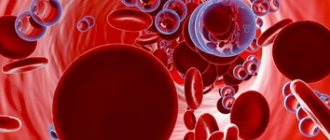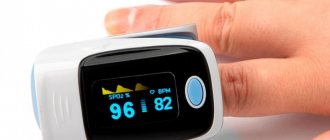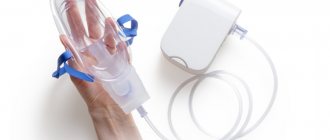Pulse oximeters are devices that measure the level of hemoglobin oxygen saturation, as well as pulse rate.
Oxygen is a vital element, since almost all vital processes of the body require its presence. If oxygen levels in the body drop, the condition is called hypoxia. And its acute shortage within just a few minutes can lead to the death of a person.
Oxygen is carried to tissues by hemoglobin, a special protein found in erythrocytes (red blood cells). Actually, due to hemoglobin, blood is red. In order for tissues to receive sufficient oxygen levels, a combination of several factors is necessary:
- Oxygen must get into the lungs, i.e. a person must breathe.
- From the alveoli, oxygen must enter the blood, i.e. alveolar gas exchange is necessary.
- The blood must contain a sufficient amount of hemoglobin.
- The heart must work adequately so that blood is pumped in sufficient volume.
- And the circulating blood volume must be adequate (there should be no bleeding).
Violation of at least one of these stages can lead to hypoxia and even death of the patient. Pulse oximeters allow real-time assessment of arterial blood oxygen saturation and detect hypoxia at the earliest stages, even before the development of clinical symptoms.
What is a pulse oximeter
A pulse oximeter is a device that is used to determine the degree of oxygen saturation in the blood ( saturation ). The pulse oximetry method is widely used in the provision of medical care, in particular, to monitor the patient’s condition in case of respiratory failure or suspicion of it; when performing operations under general anesthesia (anesthesia); during oxygen therapy; as a diagnostic method for identifying obstructive apnea syndrome, etc.
Thanks to its small size and intuitive functionality, the pulse oximeter can be used at home to detect signs of respiratory failure in the early stages. Considering that one of the most serious complications of COVID-19 is lung damage and, as a result, respiratory failure, the need to have a pulse oximeter in your home medicine cabinet is difficult to exaggerate.
Operating principle of the device for measuring saturation
In our body, hemoglobin, which is an integral part of red blood cells - erythrocytes, is responsible for transporting oxygen to organs and tissues. Each hemoglobin molecule is able to carry up to 4 oxygen molecules to its destination. If all or almost all “seats” are occupied, the degree of blood oxygen saturation will be close to 100%.
So, the operating principle of a pulse oximeter is based on a spectrophotometric method for assessing hemoglobin in the blood. Depending on the ratio of saturated and unsaturated hemoglobin, the intensity of blood color changes (the less oxygen in the blood, the darker it is). That is, in simple terms, a pulse oximeter, shining a stream of infrared light through the fingertip, records the color of the blood and determines the hemoglobin ratio. The numbers that appear on the display indicate the proportion of oxygenated hemoglobin in the blood.
Measuring in a dream
Night pulse oximetry is needed when breathing stops or becomes difficult at night. This picture is often found in diseases of the thyroid gland, obesity, hypertension, pathology of the lungs and heart. Against the background of such problems, a person suffers from sleep disordered breathing, which causes weakness, confusion, drowsiness, bad mood, and dizziness in the morning. The danger lies in the fact that death can occur in such patients during sleep.
Based on the symptoms described, the doctor suspects a lack of oxygen supply during sleep, and monitoring is needed to confirm suspicions.
Checking the degree of O2 saturation at night is done using wrist devices; they are used in a hospital or at home. This device consists of a finger sensor and a wrist strap; the patient puts it on before going to bed. There is no need to turn on the device, it turns on itself - 30,000 times a night. Typically, the inspection period lasts from 10 pm to 8 am.
There are also rules here:
- the patient should sleep in comfortable conditions, the room temperature is 20-23 degrees;
- It is forbidden to overeat, drink tea and coffee before going to bed;
- do not take sleeping pills;
- before starting the screening, you need to place a diary in front of your bed;
- the diary records all the moments when the patient woke up: time, painful sensations;
- In the morning the sensor is removed, the time of rise and sensations are recorded in the diary.
The pulse oximeter and diary are given to the attending doctor. For accurate conclusions, you will need to undergo additional examination: ultrasound, tests, examination by a cardiologist or other specialists. Based on these studies, a diagnosis is determined and treatment is prescribed.
How to choose a pulse oximeter
The market responds very sensitively to consumer needs, so finding pulse oximeters on sale in the widest range is not difficult. All devices are approximately the same in functionality, and the main differences are in design and price category. That is, by and large, you can choose a pulse oximeter for your home first aid kit based on your taste and budget.
However, we advise you to pay attention to the following points when choosing a device for measuring saturation at home:
- Look for a device that comes with a registration certificate and/or a certificate of conformity (declaration of conformity) . The presence of the document indicates that the selected pulse oximeter is medical equipment, and the safety and reliability of its operation is confirmed by a number of procedures mandatory in our country. Such devices are usually sold in pharmacies or from official representatives of medical equipment manufacturers. They are more expensive than pulse oximeters from the Internet, but they are distinguished by measurement accuracy and guaranteed service life. This is the home medical equipment you can trust . Devices without supporting documents are more affordable, but they suffer from incorrect and unstable readings and quickly break down.
- When choosing between a pulse oximeter with a liquid crystal or LED screen , give preference to the latter: it is more resistant to mechanical damage.
- Built-in memory is an excellent option if it is important for you to track the dynamics of saturation and heart rate over several days, not only for yourself, but also for your family members. If necessary, this information can be very important for the doctor.
- Automatic shutdown can also be considered an advantage when choosing a pulse oximeter, since it saves battery power. By the way, it is also better not to save on the battery itself, but to buy products from well-known manufacturers who have gained authority in the market.
How accurate are home devices?
Most healthcare professionals agree that, when used correctly, consumer models are very reliable. Experts advise sticking to finger clipping technology for now. New wearables and camera-based apps use different technology to measure oxygen saturation, and so far most of these products are unreliable. A 2021 study published in the American Journal of Emergency Medicine tested three iPhone apps that offered pulse oximetry functionality, but all fell short. The authors concluded that the apps were inaccurate and lacked the ability to accurately detect hypoxia. Thus, it is recommended to use exclusively certified and approved by doctors devices.
How to measure saturation correctly
Measuring saturation at home is quite simple. To do this, place your finger in the clamp or sleeve of the pulse oximeter. It is important that the device does not dangle, but is well fixed on the finger. After pressing the button on the instrument panel, the result appears on the screen after 15 - 30 seconds.
Important! Measurement results may be incorrect or completely absent if:
- The device dangles freely on your finger and slides off it. As practice shows, it is best to take measurements on the index, middle or ring fingers. In this case, it is desirable that the nails are cut short. Sometimes the length of the nails does not allow the pulse oximeter to be firmly fixed on the finger, which is why the readings may be distorted.
- The device is not secured correctly . The fingertip is an ideal place to measure peripheral saturation, and the readings here are most reliable for interpreting the absence or presence of hypoxia (oxygen starvation). In some cases, if it is impossible to measure saturation on the fingers, it is permissible to attach the pulse oximeter to the earlobe or toe (mainly in newborns).
- The nails are coated with varnish or gel polish . Since the operating principle of a pulse oximeter is based on shining the fingertip with infrared light and reading the results obtained with a special sensor, the coating on the nails makes this process difficult. And coating with gel polish makes it completely impossible. The stream of infrared rays simply “does not penetrate” a fashionable manicure. Therefore, to obtain reliable results, nails must be clean and uncoated, preferably of any kind.
- The device was purchased without documents confirming its reliability and safety..
Features of storage and maintenance
The device should be stored in a dry place at a temperature of 10-40 °C. Moisture can damage sensitive sensors and shorten the life of the device.
It is recommended to clean the finger hole before and after each use. You can use 70% isopropyl alcohol for this. Clean with a soft cloth. Do not spray or pour liquid onto the device. Avoid getting water into the pulse oximeter openings.
As soon as the charge indicator shows a low voltage signal, you need to change the batteries for the device to work correctly. If you do not plan to use the pulse oximeter for a long time, it is better to remove the batteries.
How to understand pulse oximeter readings
Saturation levels of 95–100% are considered normal. At the same time, numbers 99–100% are practically never found even in absolutely healthy people . If they are displayed on the monitor of your device, measure the saturation again or make sure, using the criteria given above, that there are no factors predisposing to distortion of the measurement results.
If the degree of blood oxygen saturation is below 95%, this indicates an early stage of respiratory failure and the onset of hypoxia. To reduce the load on the lungs, ease breathing and improve the supply of oxygen to organs and tissues, a person should spend most of their time in a prone position and regularly monitor the saturation level.
If the pulse oximeter measurement result is 92% or lower , the person’s condition is cause for concern and requires medical supervision. You should call a doctor or emergency medical team. Before the ambulance arrives, you need to take a prone position, and if for some reason this is not possible, ensure that the person is constantly in a half-sitting position at an angle of 60⁰ - 90⁰.
Prone position
In addition, portable pulse oximeters for home use are equipped with the function of reading another vital sign - pulse . Normally, the heart rate of a healthy adult ranges from 60 to 90 beats. An increase in heart rate can be caused by physical exertion, stress, due to the presence of chronic heart and vascular diseases, as well as a sharp decrease in the level of oxygen in the blood.
Since heart rate is not a constant value, to obtain reliable results, it is recommended to measure heart rate several times at intervals of 3-4 minutes.
The essence of pulse oximetry
We need oxygen for metabolism; without it, the body will not be able to synthesize ATP, the main energy substance. When we inhale, air enters the lungs, from where it is transported throughout the body through a network of capillaries.
Content:
- The essence of pulse oximetry
- How does a pulse oximeter work?
- Instructions for use
- Measuring in a dream
- Results: norms and deviations
- Where to buy it
Typically, the surrounding air consists of 78% nitrogen, 21% oxygen and 1% other mixtures. A healthy body can receive sufficient oxygen from such air. But with environmental pollution, in industrial zones and large cities, the composition of the atmosphere does not change for the better, the proportion of carbon dioxide and nitrogen increases. As a result, people develop chronic oxygen starvation, constant fatigue, cardiovascular system defects, drowsiness and lethargy.
Also, the body does not receive the required amount of O2 in case of diseases of the respiratory system, blood vessels and heart. The causes of these diseases can be poor diet, snoring, sedentary lifestyle, and bad habits. If left untreated, chronic lack of oxygen leads to more serious problems, including death. Therefore, a section of pulse oximetry has appeared in medicine, which is devoted to monitoring the saturation of arterial blood with O2. The average percentage of saturation is called the saturation index; normally it is 95-98%. If it decreases to 94%, the patient is prescribed treatment; if the level is below 91%, emergency medical care is required.
Pulse oximetry is needed:
- with oxygen therapy;
- after operations;
- during anesthesia;
- for monitoring in chronic diseases (for the prevention of hypoxia);
- in neonatology for the care of premature newborns;
- in obstetrics and pediatrics.
Thanks to technological advances, patients can now measure their saturation themselves. To do this, you need to buy a portable pulse oximeter and learn how to use it.
To have or not to have?
We have been living for the second year in a coronavirus pandemic – a viral infection that affects the lungs and is extremely dangerous with severe complications. Having a pulse oximeter in your home medicine cabinet is, first of all, about taking care of yourself and your loved ones, the ability to recognize an impending threat in time and seek help.
People from high-risk groups must have a device for measuring saturation:
- elderly people over 65 years of age;
- patients with chronic diseases, and, in particular, pathologies of the cardiovascular and respiratory systems;
- people with immunodeficiency;
- cancer patients.








